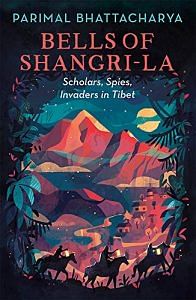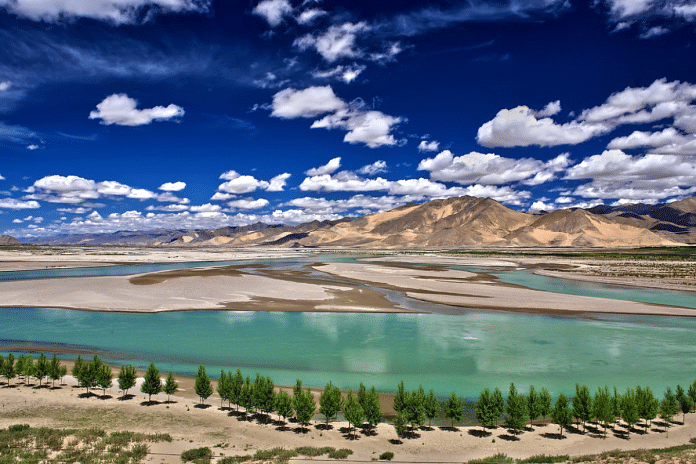Pundit Kinthup went to Tibet in 1880, the British government sent him. It took him four years to complete the mission, and this report was compiled soon after his return,’ the gentleman said, tapping the volume. ‘Thirty years later, when the McMahon Line was being drawn, Kinthup was summoned here, to Shimla, and was debriefed again. This one was based on that session.’ He pointed to the copy I was holding. ‘But if you wish to buy this printed copy, I can give it at a discounted price.’
I handed the blue felt-bound typescript back to him without a word. He moved his hand caressingly over its cover and put both the volumes together back into the shelf. In 1880, when Kinthup was sent to explore the unknown course of the Tsangpo, Tibet was a land of mystery that lay across the great mountains of the Himalayas. The mystery cast a veil over its forbidding geography and the people who lived there. By that time almost the entire Indian subcontinent had come under British rule, there was hardly any region left to be explored. But Tibet had continued to remain a blank spot on the map, a rather big spot, twenty times the size of England. For the adventurers of the Raj, there was the call of the unknown. But above this was a pang of anxiety. Across Tibet lay mighty Russia and its imperial designs. A thorough knowledge of this land on the roof of the earth was thus a matter of diplomatic necessity for the men who ruled India.
It was a matter of economic necessity as well. Since ancient times, trade routes had connected Tibet with the Gangetic plains through high mountain passes. Silk, metal, ivory, salt and food grains were exported from India in exchange for wool, butter, leather and yak tails. This had continued during the British rule, and new items like glass, indigo and cutlery had been added to the list of goods bartered. Warren Hastings, the astute Governor General in the late eighteenth century, had realized the importance of this trade link and had sent a diplomatic mission to Tibet.
Also read: How unique ‘Bazaar paintings’ fuelled trade in colonial India
It was successful. The East India Company became friends with the Panchen Lama, the priestking of western Tibet. But Hastings’ successors didn’t follow up on this friendship; rather, they became embroiled in the bickering between Nepal, Sikkim and Bhutan. With two big foreign powers, Russia and Britain, breathing down its neck, Tibet closed its doors to outsiders and tightly secured the mountain passes that led to it. It became nearly impossible for Indians from the plains, let alone white-skinned Europeans, to enter the mountain kingdom.
Tibetans and other local hill tribes monopolized trade along the high-altitude routes that remained snowbound for most of the year. The only other people who had access to them were Buddhist monks. It was relatively easy for scholars and mendicant monks to cross the passes and find shelter in the Tibetan villages, a tradition that had been going on for hundreds of years. The British began to exploit this chink. Spies disguised as monks were sent to Tibet. They were called Pundits.
The Pundits were drafted from among the hill people. They were trained in techniques of topographic survey and given instruments specially manufactured for this purpose: sextants and theodolites that could be hidden in the secret chambers of boxes, compasses fitted on walking staffs, papers and pencils tucked inside hollowed prayer wheels. Their
rosaries had one hundred beads instead of the usual one hundred and eight, to measure distances by keeping count of their paces. Sometimes it was risky to even carry papers, and they were required to cast the survey data into rhymed stanzas and commit them to memory. This way, from the notes and narrations of these Pundit-spies, lines and shades began to appear on the blank spot in the maps, above the creased mantle of the Himalayas.
But one mystery remained: What was the exact shape of the river? This river has its origin at 24,000 feet in the Tsang province in western Tibet, which gave it the name Tsangpo. It takes an easterly course along one of the innumerable parallel folds in the Himalayan mountain ranges that appear on maps like dense creases, but in reality are some of the deepest gorges on the planet.
Running east for about a thousand miles, the Tsangpo enters an impenetrable canyon to vanish into the labyrinth of knotted mountains and, within a span of 200 miles, plunges 9,000 feet, takes a sharp turn to the south and debouches into the plains of India. It is then known as Dihang and Brahmaputra. No other river in the world descends so dizzyingly steep a gradient with such an immense volume of water.
For a long time, geographers debated whether Tsangpo and Brahmaputra were one and the same river. Some argued that Tsangpo flowed east into Burma and became Irrawaddy. There were others who claimed that the river Subansiri connected Tsangpo with Brahmaputra. Two other major rivers in this region, Dibang and Lohit, complicated the matter. No less confusing was the fact that the same river is called by different names on its long journey from Tibet into India: Tsangpo, Yarlung Tsangpo, Dihang, Siang, Burha-Luit and Brahmaputra. James Rennel, the first Surveyor General of India, had guessed as early as 1765 that Tsangpo was Brahmaputra.
But the forbidding topography, the politically sensitive frontier and the warlike tribes who inhabited this region had made it impossible to find proof. The few attempts that were made on the upstream of Dihang to seek out its headwaters had ended in failure. Nobody had any doubt that a white-skinned Westerner was not fit for this mission; his physical features would be a dead giveaway.
Who, then?
In the 1870s, Darjeeling was a fledgling hill station that had been attracting workers and artisans from the villages of Sikkim and Nepal. A Lepcha man from Sikkim had come there, borne on this tide of migration. He was short, sturdy, around thirty years old, and his name was Kinthup. Kinthup did odd jobs in town until he found work as a tailor in the bazaar. Around this time the Survey of India set up an office in Darjeeling and began to send Pundits on clandestine missions into Tibet. Kinthup was picked up as an assistant of one Nem Singh, code-named G.M.N., on an exploration of the course of the Tsangpo. The mission did not yield anything, but on that assignment Kinthup displayed the three essential virtues of a secret explorer: intelligence, physical stamina and trustworthiness. Lt. Henry Harman had then joined as the chief of the survey office in Darjeeling. He was not a desk-bound officer, and he had a special interest in the riddle of the Tsangpo-Brahmaputra. It was Harman who sent Kinthup on another mission to explore the great river.
A requisite for promotion in service had forced me to join a three-week refresher course in the Academic Staff College in Shimla. The College was on Summer Hill, away from the bustle of the town, inside the leafy campus of Himachal University. A few steps away was the Viceregal Lodge, a fairytale palace of grey sandstone on a flattened hilltop, and a tiny railway station a few hundred feet below. The guesthouse where I was staying stood on a rise above the station. Every day, two pairs of narrow-gauge trains stopped on their way to Shimla and back to the hot plains; nobody got in or out.
 This excerpt from Parimal Bhattacharya’s Bells of Shangri-La has been published with permission from Harper Collins.
This excerpt from Parimal Bhattacharya’s Bells of Shangri-La has been published with permission from Harper Collins.



